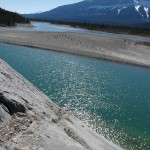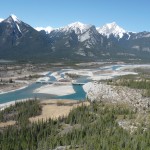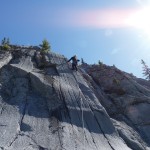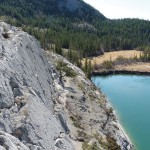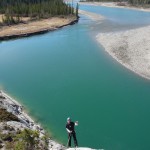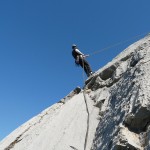Story and photos by Ross Ballard and photos by Brian Knelsen
Sometimes when I can’t sleep at night I turn on my lamp and look at the “bucket list” pinned to my bedroom wall. Split into different sections with headings such as Travel, Food, Adventures, and the most important heading, Climbing.
Under this heading are scribbled at least two dozen mountains, crags, boulders and icicles that I dream of on a regular basis. My list is based purely on the esthetic beauty of each area, and if I can get to half of them in my lifetime I will consider myself a very rich man. Among the top places I must go to are the forest of Fontainebleau in France, and the boulder fields on the South island of New Zealand, both of which offer some of the most uniquely formed limestone boulders on the planet. In the USA I want to visit the skin shredding off width cracks of Vedauwoo Wyoming and in the same state the technical stemming cracks that run the entire way up and around the stunning formation that is Devil’s Tower.
When spring is here my mind switches to local areas which I love to enjoy again and again. One of my favorite crags to visit in the spring is Morro Peak. Located just East of Jasper the roots of this beautiful little mountain run directly into the turquoise waters of the Athabasca River. The grey blue limestone offers some of the most textured and water marked stone in the area.
My climbing partners and I keep returning to this area year after year, because we can always count on the amazing friction of the rock and frequent high winds that keep the rock dry most of the season. Local climbers have done a stellar job bolting some great routes that weave their way through the pockets and runnels formed by millions of years of water running down this relatively “soft” rock face.
My friend Brian Knelsen and I leave town early and head to Jasper. All conversation stops as we pass Mt. Robson on a blue bird day. We stare silently up at her dangerous beauty and dream of future glories.
Upon arrival in Jasper we stop for some treats at the Bear Paw Bakery, and head East towards Morro Peak. We park on the East side of the Athabasca River and open the truck doors only to be blasted by super high winds. We quickly throw our lunches in our rucksacks and walk down to the river and out onto the slab leading to the first routes.
The lower slabs of Morro peak are used by local guides to teach rope skills to beginners. There are a few easier sport climbs in this area and rappelling off the anchors, we find ourselves at the water’s edge; the wind blowing my bright yellow rope sideways across the wall. There are no challenging climbs for us here, but the beauty of the surroundings give these routes a special appeal. We quickly fire off three climbs and have a snack before heading up the hill where more bolted slabs await us.
Just a few hundred metres up and over are some lovely rolling cliffs that offer more challenges. Good footwork is necessary as there are a limited number of positive holds. Brian is one of the most naturally talented climbers I’ve known, and he quickly links his route together; bolt by bolt, he weaves up a narrow gouge in the limestone.
He builds an anchor, pulls the remaining rope up and puts me on belay. I start up the gouge, unclipping Brian’s carabiners as I go. The route steepens as I focus on each foothold and use counter pressure to work my way up the wall.
I reach Brian a few minutes later, glad that it was his lead and not mine. I clip myself securely into the anchor and look up at my pitch. A slab rolls above me for ten meters then steepens severely. The route follows an arête with a thin finger crack running straight to the anchors. The sun beats down, warming the rock and giving my shoes almost unreal friction. As I start up the holdless slab I follow the old rule “heals down, ass up” and slowly walk up the face to the first bolt and the real business. I slot my fingers into the right leaning crack and grind my feet into the warm limestone, pulling and pressing my way through the bolts to a small rest twenty meters above. A few more holdless slab moves and I’m safe at the anchors. I pull up the slack in the rope and put Brian on belay below me. He moves fluidly up the wall, disappearing from view as it steepens and popping up again just a few meters away from me. We both agree that the pitch we each led felt easier than the one we followed. Strange, but that’s climbing.
We finish our day on a couple easier routes and then head back to town for a cold pint. As we walk down the trail one thing rings true in my mind. Today, we are rich men”.



